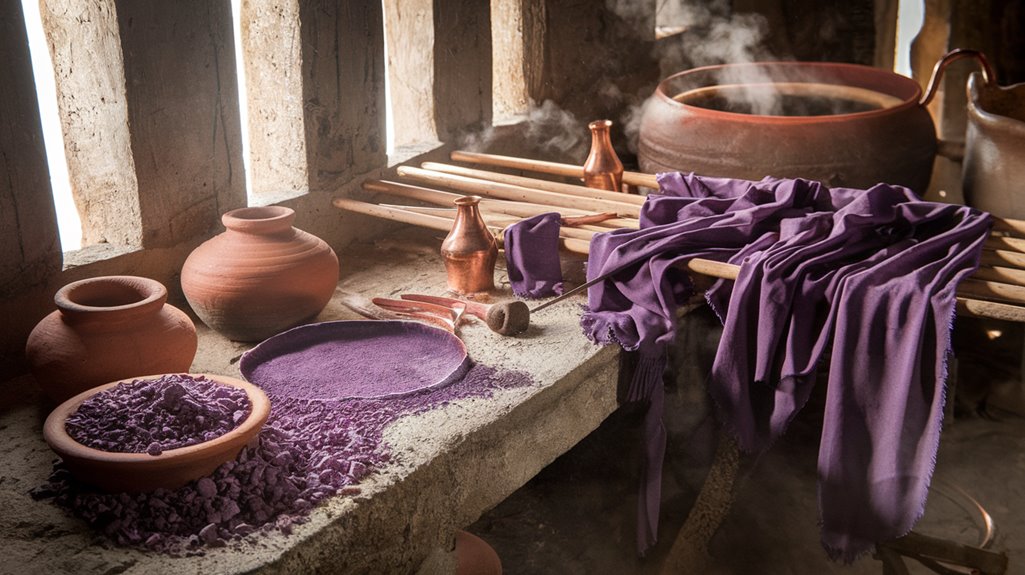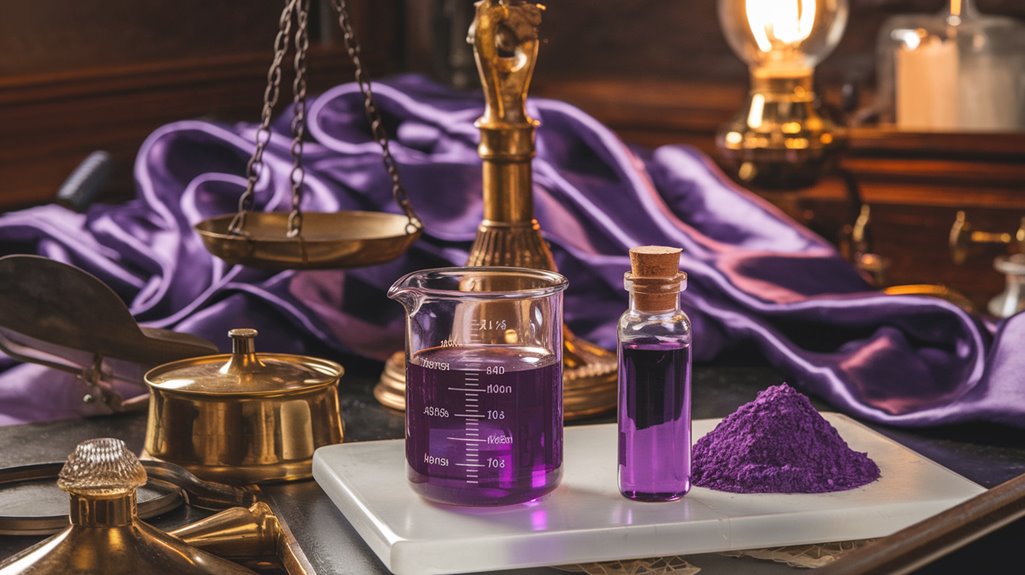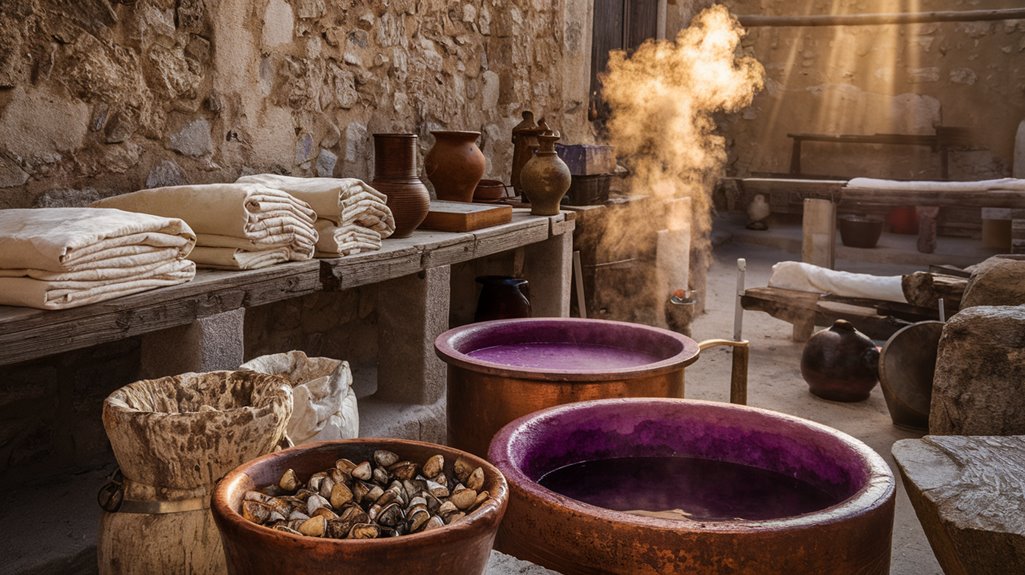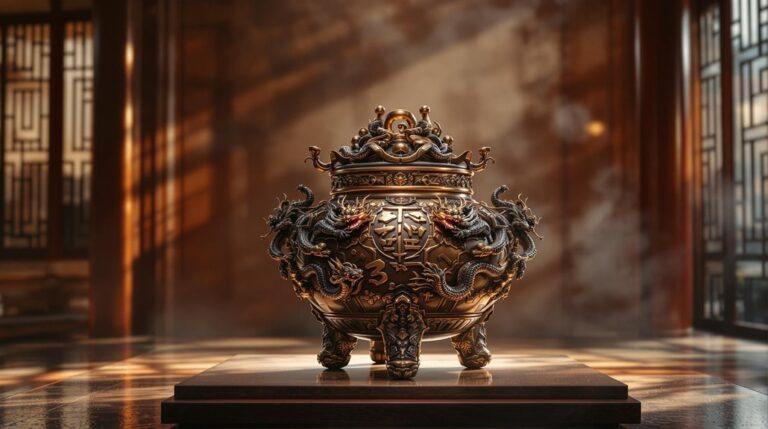Purple Became Associated With Royalty Due to Expensive Dye
You've likely worn purple clothing without giving it a second thought, but there was a time when that simple color choice could have landed you in serious trouble. The story of purple's rise to royal status isn't just about aesthetics – it's a tale of ancient chemistry, maritime trade, and strict laws that shaped society's relationship with a single hue. What made this color so special that emperors would guard it as fiercely as gold?
The Discovery of Nature's Most Precious Dye

While many ancient discoveries have been lost to time, the origin of Tyrian purple stands as one of history's most fascinating finds. You can trace its beginnings to the ancient city of Tyre in modern-day Lebanon, where craftsmen first developed the dyeing processes during the Middle Bronze Age around 2000 BC.
Recent archaeological findings have disclosed remarkable insights into these ancient techniques. On the Greek island of Aegina, researchers discovered a 3,600-year-old dye workshop containing preserved residues and tools.
They found evidence that three specific mollusk species were essential to creating this precious pigment: the banded dye-murex, spiny dye-murex, and red-mouthed rock shell. It took approximately 12,000 snails to produce just one gram of this valuable dye. The Phoenician civilization was credited with this groundbreaking discovery of purple dye production around 3,000 years ago.
The workshop also revealed mammal remains, suggesting either religious rituals or temperature control methods were part of the complex production process.
Ancient Production Methods and Their Challenges
Although modern dye production is straightforward, creating Tyrian purple in ancient times posed extraordinary challenges. You'd need thousands of snails just to produce a tiny amount of this precious dye, making the ancient techniques incredibly resource-intensive.
The dye extraction process was complex and time-consuming. Workers would collect the Murex brandaris snails and carefully remove their glands, either by stimulating them to release their secretion or by crushing the snails entirely. A recent excavation in Crete revealed high-quality artifacts indicating the wealth generated from this industry.
They'd then mix these glands with saltwater in lead pots and heat the mixture for about ten days until it turned reddish-purple. Due to the process's overwhelming stench, production sites had to be located downwind from populated areas.
Special tools, including grinding implements and stone tanks for farming the snails, were essential to the operation. A significant discovery of pigmented ceramics at the Kolonna workshop site provided crucial evidence of this ancient manufacturing process.
The Cost That Made Purple a Royal Symbol
Because Tyrian purple required up to 12,000 mollusks to produce a single gram of dye, its cost equaled its weight in gold – roughly half a Roman soldier's yearly salary or $66,000 in today's money.
This astronomical expense shaped historical trade and created a strict societal hierarchy around the color's use. Downwind manufacturing sites were necessary due to the pungent smell of production. Even Queen Elizabeth I strictly controlled purple's use through royal decrees.
You'll find that the dye's extreme value led to three significant impacts:
- Roman emperors enforced death penalties for commoners who dared to wear purple.
- The Byzantine Empire restricted purple ink signatures to rulers only.
- The dye became so precious that merchants traded murex snails at gold-equivalent prices.
The color's prohibitive cost naturally limited its use to nobility and rulers, cementing purple's status as the ultimate symbol of power and authority across ancient civilizations.
Laws and Regulations Protecting Purple's Status
Throughout history, ancient civilizations enforced strict laws to protect purple's status as a royal color. In the Roman Empire, you'd find only emperors and official seers wearing purple garments, while senators could display just a purple stripe on their togas. The prestigious position of Roman Censor determined which senators were worthy of wearing the purple-trimmed toga.
The legal enforcement was similarly strict in the Byzantine Empire, where purple became deeply embedded in royal traditions – empresses gave birth in the Purple Chamber, and rulers "born to the purple" held special status.
During the Elizabethan era, the social hierarchy was maintained through sumptuary laws that limited purple wear to royal family members and their closest relatives. The dye's rarity and high cost came from the mucus of sea snails harvested near the ancient city of Tyre.
If you violated these regulations, you'd face severe penalties, as demonstrated by Henry Howard's trial. Rulers across civilizations controlled purple's production and distribution to maintain its exclusive status.
The Rise of Synthetic Purple and Its Impact

The rigid control over purple's royal status changed dramatically in 1856 when William Henry Perkin accidentally discovered the first synthetic purple dye. His breakthrough in dye production revolutionized the textile industry, making purple accessible to everyone.
What started as a failed attempt to synthesize quinine became one of history's most impactful synthetic innovations. The young 18-year-old student made this groundbreaking discovery while studying at the Royal College of Chemistry. The resulting dye produced a reddish powder that would transform the industry forever.
The impact of Perkin's discovery was far-reaching:
- You could now buy purple clothing at a fraction of the traditional cost, as synthetic dyes replaced expensive natural sources.
- The textile industry expanded globally, with Germany initially dominating 70% of worldwide dye sales.
- Social barriers broke down as purple's exclusivity diminished, allowing people of all classes to wear the formerly royal color.
The development of synthetic purple marked the beginning of modern dye chemistry and democratized fashion forever.
Purple's Legacy in Modern Culture and Fashion
While synthetic purple dyes revolutionized fashion accessibility in the 1850s, purple's cultural significance hasn't diminished in modern times.
You'll find purple in design across various platforms, from Prince's iconic wardrobe to Versace's vibrant patterns in their Spring/Summer 2025 collection. The color's cultural symbolism continues to evoke luxury, creativity, and wisdom in contemporary society. Leading fashion houses like Victoria Beckham and Dior are showcasing rich violet tones in their winter 2025 collections.
Today, you can see purple's influence in everything from Sergio Hudson's sophisticated suiting to PH5's innovative knitwear. The trend extends into softer variations with periwinkle and lilac dominating the seasonal palette.
The Spring/Summer 2025 season particularly embraces this royal hue, featuring shades ranging from soft lilac to deep violet.
Whether you're exploring high fashion or popular culture, purple's legacy remains powerful, reflecting both its historical prestige and modern versatility in fashion and design.










